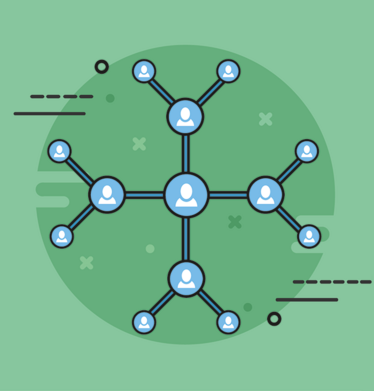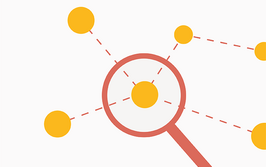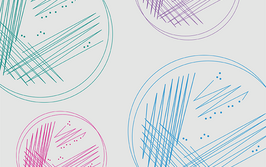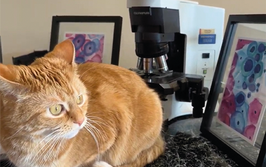
Going Viral
How social media posts are providing doctors with a new diagnostic and epidemiological tool
With the digital revolution firmly underway, pathologists hear a lot about new microscopes, automation devices and long-distance reporting software designed to make their jobs easier. But now, a different kind of diagnostic tool is catching physicians’ attention: social media. It’s a tool I recently had cause to experience for myself, as my colleagues and I dealt with a cluster of cutaneous leishmaniasis cases that had arisen in a youth group on a trip to Israel – noteworthy because we were able to detect this cluster thanks to the teens’ social media posts (1).
The original pictures of the leishmaniasis lesions were taken by the kids themselves. One of them shared the very first photograph with friends after diagnosis by traditional means – and once the first picture was distributed, other kids replied over social media, sharing their own lesions along with the likely diagnosis. By the time the fourth or fifth child had made a doctor’s appointment, they were actually suggesting the diagnosis themselves (often along with showing the photographs they’d taken, or sending them to offices at the doctors’ request). My co-authors and I alerted one another to the presence of an outbreak fairly early on, after gathering histories from our patients and using the Emerging Infections Network (EIN; ein.idsociety.org), an online resource for infectious disease monitoring. After that, we were able to track leishmaniasis cases and provide information as needed – something that might never have happened without the teens’ initial ability to share their diagnoses and the doctors’ subsequent ability to connect with one another.

Public posting about public health
The utility of social media for disease diagnosis and monitoring is actually an emerging area of study, and we’ve heard of a number of other experiences similar to our own. For instance, in 2012, Facebook was used to help diagnose a group A streptococcal outbreak (2), and reports on other platforms like the review site Yelp have allowed us to not only spot outbreaks, but identify the foods responsible (3). The information doesn’t just flow one way, though – doctors have also used social media to alert patients and communities of outbreaks in places ranging from college campuses to war zones (4–6). Even some public health systems have set up successful systems for citizens to report outbreaks; Chicago, for instance, has an online food poisoning alert form (foodbornechicago.org).
Social media is here to stay, and people are going to use it to share stories about their health. If we as providers and epidemiologists can find a way to harness this ubiquitous form of communication, we not only become better informed ourselves, but we can effectively partner with the community at large to track, diagnose and hopefully stop outbreaks. Learning more about how to best leverage social media will require traditional epidemiologists to partner with scientists conversant with large-data analytics, so that they can sift through the massive amount of traffic that social media sites experience. Picking out relevant data will be a challenge, but it’s one I believe is worthwhile for the knowledge we can gain.
Social media safety
There isn’t much guidance available to healthcare professionals who want to use social media for epidemiology – or any other innovative purpose. Current guidelines (set by individual institutions, medical boards, or organizations) focus on protecting patients’ privacy and ensuring that providers maintain a professional relationship with them online. They tend to be focused on physician-patient relationships, assuming that doctors will use social media as a tool to communicate with individuals and occasionally post more broadly regarding public health (for instance, offering advice on using sunscreen, keeping up with vaccinations, water safety, and more). Outbreak reporting and monitoring is so new that most of these guidelines don’t even acknowledge, much less address, the possibility.
My advice to healthcare providers on social media? As far as communicating directly with your patients, or with other providers about particular patients, make sure to look up your institution’s guidelines on social media communication and sharing; those are usually in line with both good ethical practice and legal protections for patient privacy. Obtain a patient’s direct consent before sharing, posting, messaging or tweeting any details about the case. From a laboratory standpoint, I advise against any sharing of patient samples (for instance, as photographs or videos). These are a minefield of protected health information. Labs that want to participate in online campaigns regarding public health should use the Centers for Disease Control and Prevention (CDC) social media toolkit (2) to maintain best practices and get their message out. As far as patients communicating with one another, it’s up to them – but I suggest that physicians advise patients to look after their personal information; it can be disseminated quickly if they’re not careful.
The main source of outbreak reporting by healthcare workers in the United States is the CDC. Although their toolkit for communicating outbreaks over social media is useful, the key thing to remember is that it’s still just as important to be aware of your patients’ privacy and their individual rights, especially when sharing photographs where patients can be identified. That can be an issue for pathologists who may need to share images of their patients for disease identification, consultation, or monitoring. Luckily, it wasn’t a problem for us, because our patients mainly spoke to one another over social media and then brought the outbreak to our attention in person. We were able to avoid the potential pitfalls of social media use by not disseminating any patient information – they did that themselves.
The strength of sharing
It’s a wonderful thing to be able to partner with the non-medical to help diagnose and treat disease. If people take the initiative to participate in their own care, everyone benefits. This is true for outbreak reporting (in our case), treatment and monitoring (as when parents and loved ones can take care of sick family members and report to their doctors), emergency response (when people can almost instantly communicate environmental and health conditions), and more – and information can flow from the provider to the public, or from the public back to the provider.
The greatest advantages of social media are rapid communication and an “amplification” effect, as certain topics start to trend on social media and are more frequently shared. In the case of our leishmaniasis outbreak, one teenager was diagnosed, and in a matter of days more than 10 others knew what infection they had and whom to talk to about it. Likewise, the treating physicians were able to quickly communicate their findings with one another using the EIN. Before social media became commonplace, this level of recognition might have taken weeks.
The biggest disadvantage, though, is that we’re dealing with a massive amount of data. Everyone on social media has an equal voice – whether they’re laymen or trained professionals. That means that there is a potential for false reporting, of course – but more importantly, it poses the problem of separating fact from fiction. If a public health agency is monitoring social media in order to detect outbreaks or other health emergencies, they’ll need a method by which to sift through the torrent of information and identify which reports need follow-up.
My dream for the future is that social media will allow anyone to connect to their medical teams and healthcare agencies, so that they can discuss their health and the health of their community without compromising privacy. My colleagues and I would also love to see the EIN used more broadly to inform fellow healthcare workers of outbreaks and emergencies, and crowdsourced consulting (medscape.com/consult) used to request assistance and second opinions from colleagues anywhere on the planet. These tools must be used with caution, though, because there are restrictions on the information that can be shared – and that can lead to faulty consultation. It’s our job to ensure that we’re using these systems as well as possible, but also to keep in mind their limitations.
The application of social media to healthcare is definitely a field of rapid growth – from simple posting all the way to using advanced analytics to track pandemics. Just as we had to create laws and ethics to communicate with patients in our offices and via telephone, we will have to address questions of privacy and public information on the Internet as well. The benefits are worth the teething troubles, though, as our world becomes increasingly connected and healthcare information is freely available with the click of a “Share” button.
Santhosh Nadipuram is a postdoctoral research fellow in Microbiology, Immunology and Molecular Genetics at the University of California, Los Angeles, USA.
- MS Majumder et al., “Substandard vaccination compliance and the 2015 measles outbreak”, JAMA Pediatr, 169, 494–495 (2016). PMID: 25774618.
- D Callender, “Vaccine hesitancy: more than a movement”, Hum Vaccin Immunother, 12, 2464–2468 (2016). PMID: 27159558.
- DA Broniatowski et al., “Effective vaccine communication during the Disneyland measles outbreak”, Vaccine, 34, 3225–3228 (2016). PMID: 27179915.
- K Mongkolrattanothai et al., “Leishmaniasis gone viral: social media and an outbreak of cutaneous leishmaniasis”, Pediatr Dermatol, 33, e276–e277 (2016). PMID: 27469423.
- SK Kemble et al., “Foodborne outbreak of group a streptococcus pharyngitis associated with a high school dance team banquet – Minnesota, 2012”, Clin Infect Dis, 57, 648–654 (2013). PMID: 23868521.
- EO Nsoesie et al., “Online reports of foodborne illness capture foods implicated in official foodborne outbreak reports”, Prev Med, 67, 264–269 (2014). PMID: 25124281.
- Centers for Disease Control and Prevention, “Mycoplasma pneumoniae outbreak at a university – Georgia, 2012”, MMWR Morb Mortal Wkly Rep, 62, 603–606 (2013). PMID: 23903594.
- E Coughlan et al., “A novel response to an outbreak of infectious syphilis in Christchurch, New Zealand”, Sex Health, 12, 170–173 (2015). PMID: 25493444.
- S Alasaad, “War diseases revealed by the social media: massive leishmaniasis outbreak in the Syrian Spring”, Parasit Vectors, 6, 94 (2013). PMID: 23587258.
Santhosh Nadipuram is a postdoctoral research fellow in Microbiology, Immunology and Molecular Genetics at the University of California, Los Angeles, USA.




















